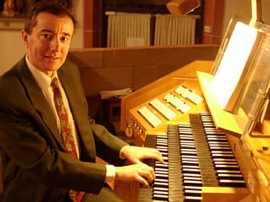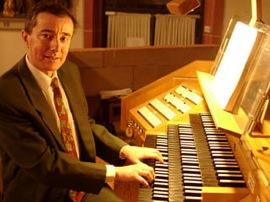
This was, fortunately, not the case Friday when Mantoux offered his generous, expressive interpretations of French repertoire on the fine Petty-Madden organ at Berkeley’s First Congregational Church. In his opening number, Alexandre Boëly’s Fantasy and Fugue in B-flat Major, he almost went out of his way to overemphasize the downbeat of each measure of the toccatalike opening section of the piece, as if to say, “Don’t worry, I actually enjoy playing this music.” In truth, it was a bit excessive, as it began to obscure the flow of the 16th-note movement, but he managed to settle down as the piece progressed into the fugue section. Throughout the piece (actually, throughout the entire program), his registrations were balanced and lucid and his dynamic adjustments smooth and deftly handled: no mean task on an organ of this size (62 ranks) and capable of, frankly, deafening volume.
The next two pieces on the program were particularly revealing, since they normally exemplify two distinct compositional approaches from the same era. César Franck’s B-minor Chorale is considered to be the apotheosis of his highly emotional and expressive style, while the Allegro from Charles-Marie Widor’s Sixth Symphony is one of the great technical showpieces in the repertoire. It was no surprise that Mantoux’s approach to Franck’s work reflects a deep connection to that composer. He never missed an opportunity to bring out the score’s expressive quality. For instance, at the beginning of the middle section, a high solo B underscored by two explosive chords, he held the note just a tad longer than directed, exploiting the potential energy of the moment, then released the note to continue its tortuous fall into the harmonic depths.
More surprising was his interpretation of the Widor. He was more than up to the music’s technical challenges, and brought a sense of sweep to the driving outer sections of the piece while introducing an expressive, even argumentative, quality to the developmental section. Yet this was an argument from an individual who was willing to hear other points of view. At climactic moments of the piece, the organ became almost vocal as he stretched the phrases to their maximum tipping points. Still, when he needed it, as in the recap where the secondary theme is played in unison by the hands and the feet, the drive was there. I have heard this piece played many times, and I have never heard it played better.
Time to Reflect
Two short pieces by Jehan Alain followed, the rarely heard Lamento and the popular Litanies. In the former, Mantoux made use of the darker colors of the organ in a stark, desolate manner, even as he ripped through the latter piece in typical French fashion, though always pausing generously at the commas, as if to give penitent petitioners a time to breathe and collect their thoughts before the next round of prayers. The ending was ferocious in its intensity.Mantoux closed with Maurice Duruflé’s Suite, Op. 5. Of all his sparse compositional output, this is the composer’s darkest music, and he was apparently never totally comfortable with having written it, especially the final Toccata. Mantoux was not apologetic in his interpretation, though, virtually calling up the demons from the depths in the opening Prelude. The Sicilienne (which really has nothing to do with Sicily, unless you think of it as a leisurely walk in a Faustian wood with Mephistopheles portraying a Mafioso don lurking behind the trees) featured the organ’s wailing clarinet stop over a well-paced accompaniment.
This Toccata is a dance of death that strikes fear into the hearts of players and audiences alike, not just for the technical challenge but for the interpretive one, as well. So many starts and stops occur in the piece’s final third that it’s akin to watching a race where the cars rev their engines only to turn off the ignition when the pedal is down. The organist has to tread carefully and provide a sense of momentum where it doesn’t really exist. Mantoux found the right balance of expressivity where it was needed, yet he didn’t dwell needlessly on the rests in between the final sections. At the end, he drove the piece over the expected cliff, to thunderous applause.
So, if technique is in the service of interpretation, Christophe Mantoux is a shining example of this, and he’ll have no trouble winning over converts to the French approach to literature. He can even improvise, as he showed in his unannounced encore. Wait, they teach that in France, don’t they?

